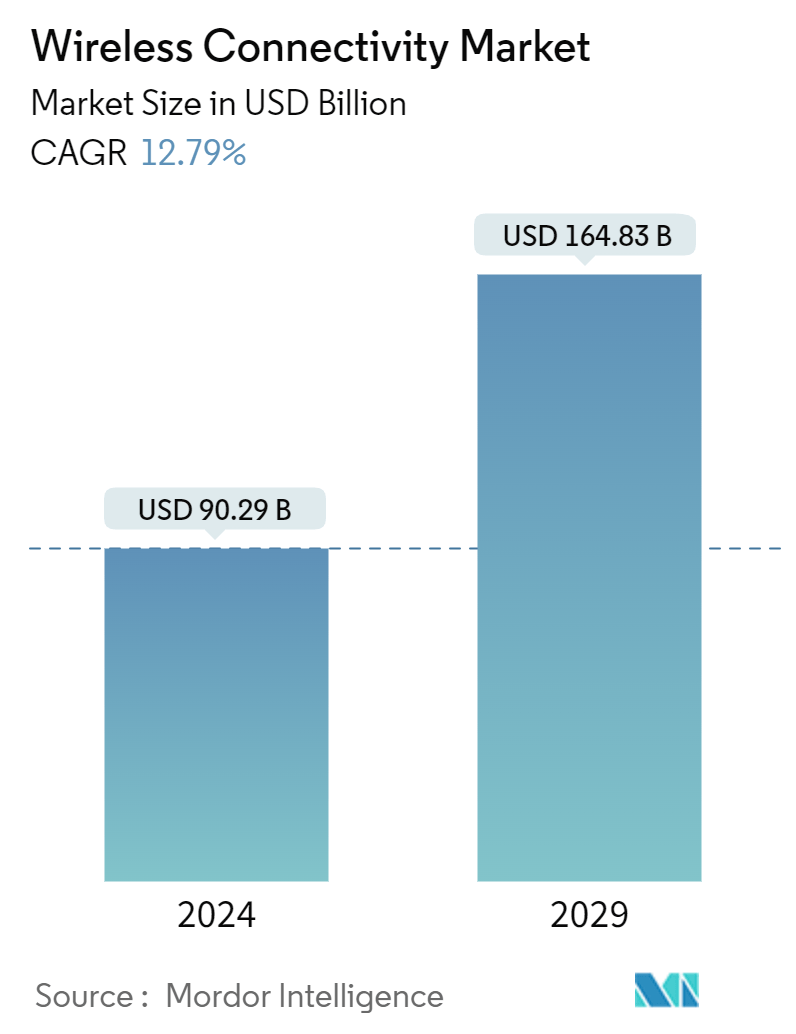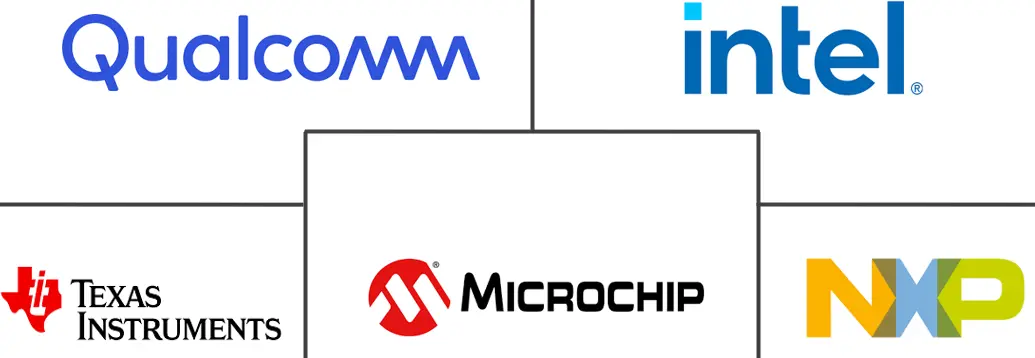Market Size of Wireless Connectivity Industry

| Study Period | 2019 - 2029 |
| Market Size (2024) | USD 90.29 Billion |
| Market Size (2029) | USD 164.83 Billion |
| CAGR (2024 - 2029) | 12.79 % |
| Fastest Growing Market | Asia-Pacific |
| Largest Market | North America |
Major Players
*Disclaimer: Major Players sorted in no particular order |
Wireless Connectivity Market Analysis
The Wireless Connectivity Market size is estimated at USD 90.29 billion in 2024, and is expected to reach USD 164.83 billion by 2029, growing at a CAGR of 12.79% during the forecast period (2024-2029).
- The wireless connectivity market is experiencing significant growth, driven by the increasing demand for seamless internet access and interconnected devices encompassing various technologies, including Wi-Fi, Bluetooth, and Zigbee, enabling data transmission without requiring cables.
- The proliferation of connected devices across various sectors like healthcare and smart homes drives demand for low-power, short-range connectivity solutions, such as Bluetooth and Zigbee. For instance, Amazon’s growing portfolio of Echo smart speakers leverages Wi-Fi and Bluetooth technology for connectivity. In addition, the growing consumer interest in smart home devices, such as smart thermostats, lighting, and security systems, is boosting the demand for wireless connectivity.
- The increasing demand for consumer electronic devices drives the market's growth. Adopting advanced technologies like AI, IoT, AR, and VR is also accelerating demand for wireless connectivity across various industry verticals. The global development of smart infrastructure is also a significant factor in the increasing demand for wireless connectivity.
- Moreover, the increasing investment by governments globally in smart city projects that use wireless connectivity for various applications is propelling the market's growth. For instance, in October 2023, the Department of Information Technology, Electronics & Communication (DITE&C) announced a plan to set up and operationalize more than 100 Wi-Fi hotspots across the state to provide free and seamless internet services. The hotspots will be at selected government offices, bus stands, public parks, citizen service centers, and other locations with high footfalls.
- However, security concerns are restraining the wireless connectivity market's growth as wireless networks are vulnerable to cyberattacks. As wireless communication continues to grow across industries and applications, strong security measures are essential to prevent data breaches and malware attacks. Poor encryption protocols, weak authentication mechanisms, and vulnerable network configurations can reveal sensitive information and compromise the security of wireless systems.
- For instance, according to a survey by the Wireless Broadband Alliance (WBA) as part of the WBA Annual Industry Report 2023, more than a third (33%) of service providers, technology vendors, and enterprises already plan to deploy Wi-Fi 7 by the end of 2023. Further, 44% are planning to adopt Wi-Fi 6E in the next 12-18 months. Such growth prospects in adopting Wi-Fi are anticipated to add significant growth to the wireless connectivity market.
Wireless Connectivity Industry Segmentation
The wireless network comprises a computer network that utilizes wireless data connections between network nodes. Various end-user segments use wireless connectivity to address critical connectivity issues and augment daily operational requirements.
The wireless connectivity market is segmented by technology (wi-fi, bluetooth, zigbee, and other technologies), end-user industry (automotive, industrial, healthcare, energy, infrastructure, and other end-user industries), and geography (North America, Europe, Asia-Pacific, and rest of the world). The market sizes and forecasts are provided in terms of value (USD) for all the above segments.
| By Technology | |
| Wi-Fi | |
| Bluetooth | |
| Zigbee | |
| Other Technologies |
| By End-user Industry | |
| Automotive | |
| Industrial | |
| Healthcare | |
| Energy | |
| Infrastructure | |
| Other End-user Industries |
| By Geography*** | |
| North America | |
| Europe | |
| Asia | |
| Latin America | |
| Middle East and Africa |
Wireless Connectivity Market Size Summary
The wireless connectivity market is poised for substantial growth, driven by the increasing demand for seamless internet access and the proliferation of interconnected devices. Technologies such as Wi-Fi, Bluetooth, and Zigbee are at the forefront, enabling data transmission without the need for cables. The surge in connected devices across sectors like healthcare and smart homes is fueling the demand for low-power, short-range connectivity solutions. Consumer interest in smart home devices, coupled with the adoption of advanced technologies like AI, IoT, AR, and VR, is further propelling market expansion. The global development of smart infrastructure and significant government investments in smart city projects are also key contributors to the market's growth trajectory. However, security concerns related to wireless networks, such as vulnerabilities to cyberattacks, pose challenges that need to be addressed to ensure continued market advancement.
In the automotive sector, the integration of wireless connectivity in vehicles is enhancing features like hands-free calling, audio streaming, and in-car infotainment systems. The rise of autonomous vehicles and connected cars is driving demand for advanced wireless solutions, as these technologies increasingly resemble mobile IoT devices. The market is characterized by a fragmented competitive landscape, with major players like Qualcomm, Intel, and Texas Instruments actively engaging in strategic developments such as product launches and collaborations. The expansion of 5G networks and the rapid adoption of IoT platforms, particularly in regions like East Asia and the Pacific, are expected to significantly impact market growth. Recent innovations, such as new Wi-Fi and Bluetooth modules, underscore the industry's commitment to meeting diverse consumer needs in terms of size, cost, and power efficiency.
Wireless Connectivity Market Size - Table of Contents
-
1. MARKET INSIGHTS
-
1.1 Market Overview
-
1.2 Industry Value Chain Analysis
-
1.3 Industry Attractiveness - Porter's Five Forces Analysis
-
1.3.1 Bargaining Power of Suppliers
-
1.3.2 Bargaining Power of Consumers
-
1.3.3 Threat of New Entrants
-
1.3.4 Threat of Substitutes
-
1.3.5 Intensity of Competitive Rivalry
-
-
-
2. MARKET SEGMENTATION
-
2.1 By Technology
-
2.1.1 Wi-Fi
-
2.1.2 Bluetooth
-
2.1.3 Zigbee
-
2.1.4 Other Technologies
-
-
2.2 By End-user Industry
-
2.2.1 Automotive
-
2.2.2 Industrial
-
2.2.3 Healthcare
-
2.2.4 Energy
-
2.2.5 Infrastructure
-
2.2.6 Other End-user Industries
-
-
2.3 By Geography***
-
2.3.1 North America
-
2.3.2 Europe
-
2.3.3 Asia
-
2.3.4 Latin America
-
2.3.5 Middle East and Africa
-
-
Wireless Connectivity Market Size FAQs
How big is the Wireless Connectivity Market?
The Wireless Connectivity Market size is expected to reach USD 90.29 billion in 2024 and grow at a CAGR of 12.79% to reach USD 164.83 billion by 2029.
What is the current Wireless Connectivity Market size?
In 2024, the Wireless Connectivity Market size is expected to reach USD 90.29 billion.

